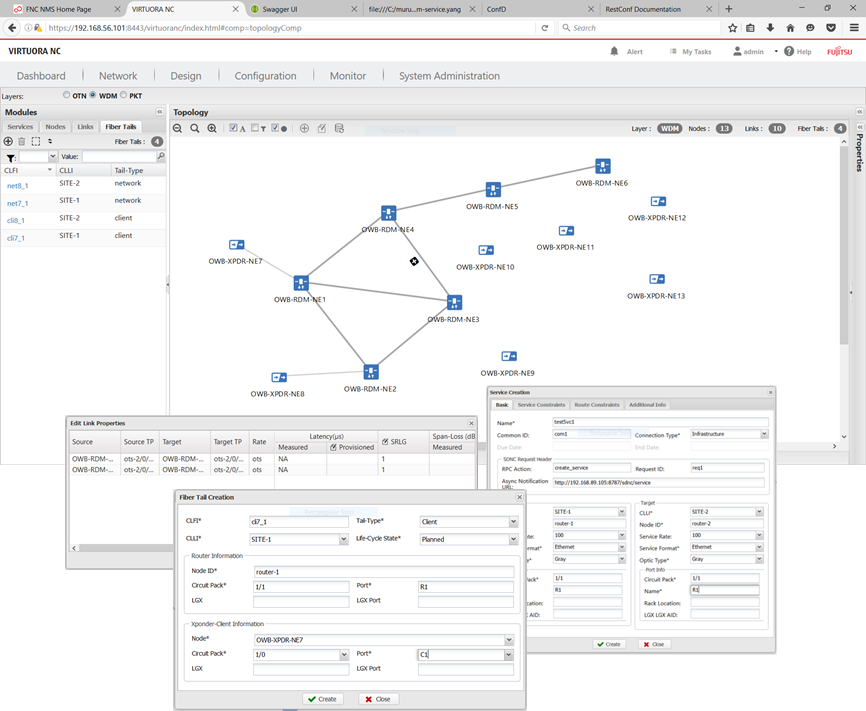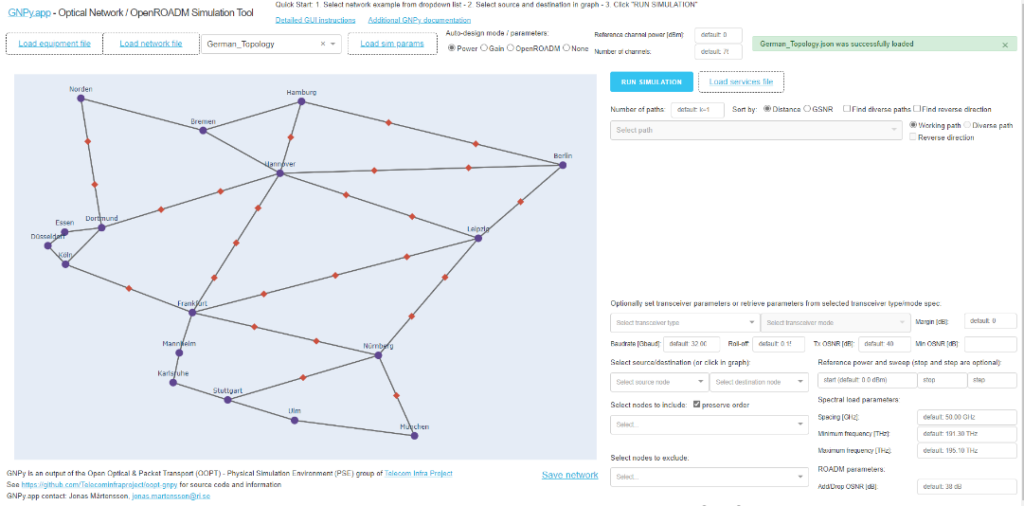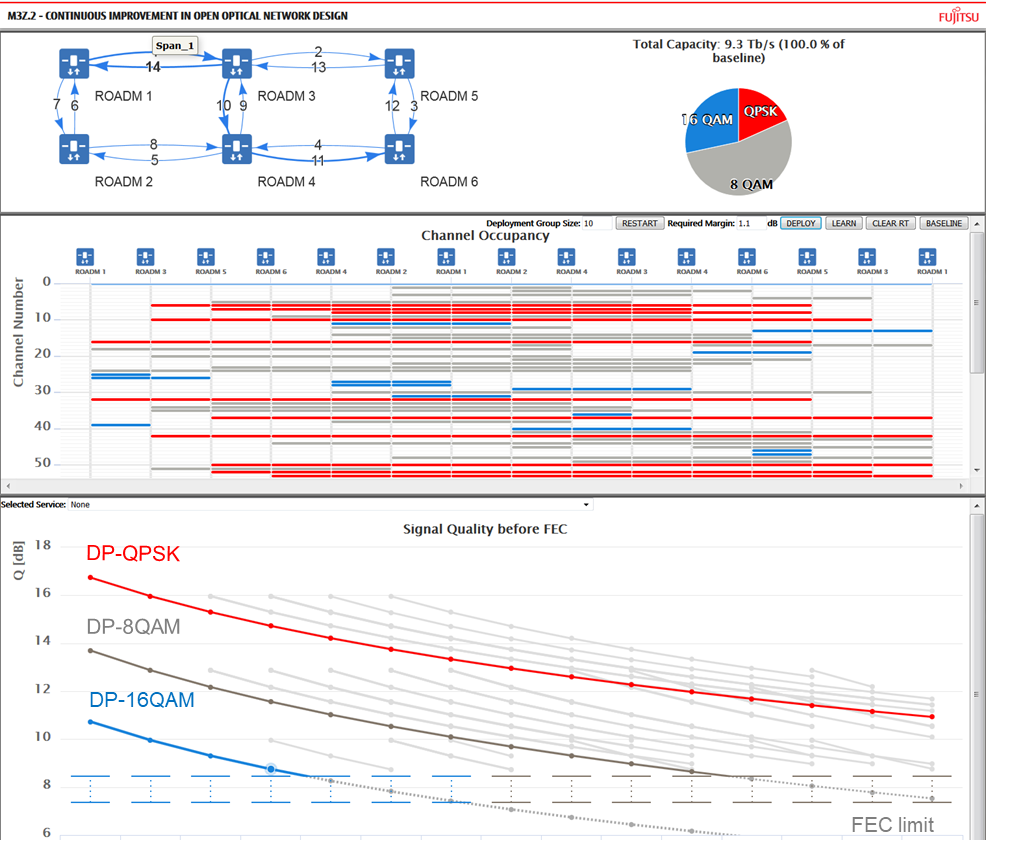The Open Optical Networking Blogs, part 5

In this blog series, Fujitsu’s Francois Moore explores the key issues and current developments in open optical networking. The topics addressed include Adding Alien Wavelengths, Controlling Multi-Vendor Optical Networks, Opening the ROADM network, Disaggregating the Transponder, and Planning with Multi-Vendor Optical Design Tools.
The optical design tool is the last important piece to the open optical networking puzzle. Its key function is to calculate the optical reach of a wavelength based on modulation, launch power, forward error correction (FEC), fiber type, distance and other parameters. Design and planning are essential to:
- Ensuring that service level agreements (SLA) are met
- Planning failure scenarios and rerouting
- Optimizing spectral efficiency across the network
Just how far a wavelength can travel depends on the optical fiber and the ROADM & amplifier equipment deployed along the wavelength. The optical fiber introduces non-linear distortion. The modeling of this noise is well understood, and it is mostly independent from the equipment.
By contrast, the signal degradation introduced by the ROADM and amplifier is almost entirely vendor dependent. These systems are built around a Wavelength Selectable Switch and erbium doped fiber amplifiers (EDFA). Different grades of EDFA amplifiers, the addition of “noise-free” Raman amplifiers as well as specific design details around optical power management create performance differences between vendors.
For single-vendor networks, the vendor provides a proprietary design tool. The vendor’s detailed technical specifications are built into the tool. But when the ROADM, transponders and/or optical pluggable interfaces are sourced from multiple vendors, such a proprietary tool will not work since it requires the specifications from every vendor – which are typically confidential.
Fortunately, three multi-vendor tools are available today: Open ROADM, GNPy, and OLS Designer. Each one takes a different approach and has unique strengths. Depending on the service provider’s situation, one (or more) will be suitable.
Approach #1: Design around standards
Networks compliant to open standards like the Open ROADM MSA are, in many ways, the most straightforward to design. This is because the standard specifies the acceptable technical parameters for the common interfaces and APIs among the network equipment and controller, so there is no vendor proprietary information. The specifications are open, public, and available for download.
This means that most vendors’ design tools – provided they support these user-defined technical parameters – can be used to design an Open ROADM-compliant network. Once the Open ROADM specifications are loaded, the equipment, fiber and network topology defined, then the design process can begin.
Virtuora® PD, from Fujitsu, is one such example that has been used to design operational Open ROADM networks. It provides optical reach calculations and even comes with the feature suite to generate site-by-site installation information.

Approach #2: Focus on the fiber
GNPy (Gaussian Noise Model in Python) is an open-source design tool spearheaded by TIP (Telecom Infra Project). It completely avoids requiring any vendor proprietary information as it ignores the varying signal degradation caused by different vendors’ ROADMs and amplifiers. It does require some vendor specific transponder specifications, but this information is typically not as restricted. On the optical side, it currently only considers the non-linear effects introduced by the fiber. This approach assumes that the non-linear noise associated to the transmission within the fiber can be modeled as a Gaussian distributed noise where the noise’s mean and standard deviation is a function of the amplification, fiber length, and fiber type.

This, at first, might seem like a major shortcoming of GNPy. Can I trust the result if the tool ignores the additional penalty caused by the ROADM and amplifiers? In all fairness, most of the non-linear signal degradation in an optical network is caused by the fiber and a simple approach is to estimate a fixed penalty for the equipment. This additional margin eliminates the need for detailed equipment specifications, though at the cost of producing perfectly optimized designs.
The Fujitsu Virtuora NC network controller is also being integrated with GNPy as part of the TIP CANDI initiative. As such, it will be the first commercial SDN controller to support integration with GNPy.
Approach #3: Machine Learning design using network data
Brownfield network designs typically add services to an existing infrastructure. In a multi-vendor situation this often means adding an alien wavelength with transponders sourced from vendors other than the incumbent.
Fujitsu has introduced the Virtuora AX OLS Designer MicroApplication, a new AI-based tool that optimizes and plans services in brownfield applications. The tool has the ability to retrieve the network topology, the existing active wavelengths as well as the current received signal quality by reading the bit error rate (BER) of the individual wavelengths.

This information is then used to calculate the noise contribution of every link within the network topology and build a noise contribution representation. Then, it can estimate the reachability of any additional wavelengths added to the system using the standard optical reachability calculation methodology.
The novelty of this approach lies in the fact that it uses the actual network data to assess the network’s performance and calculate the expected performance of any additional circuits. This tool can be used for multiple applications:
- Estimate the optical reachability of an alien wavelength when there is little knowledge of the underlying ROADM’s specifications
- Assess if an existing circuit operating at, say 100G, can be increased to 200G
- Monitor optical margin degradation
- Calculate reachability across multiple successive ROADM networks from different vendors. This application allows for the elimination of the “back to back” transponders typically deployed between two ROADM networks
The OLS Designer abstracts the network and can be used to model network and services from any vendor. This exciting new tool is part of Fujitsu’s microapplications introduced under the Virtuora AX portfolio.
Summary
With three different planning and design tools now available, each with a different focus and approach, building multi-vendor networks is easier than ever before. Deploying alien wavelengths? Use the OLS Designer. Building a fully interoperable Open ROADM network? Use your current design tool. Worried about fiber distortions on a long span? Use GNPy. Even with the right tool for the job, don’t forget the golden maxim: measure twice, cut once. Or, in optical transport terms: plan, design, approve, install, activate, and test.